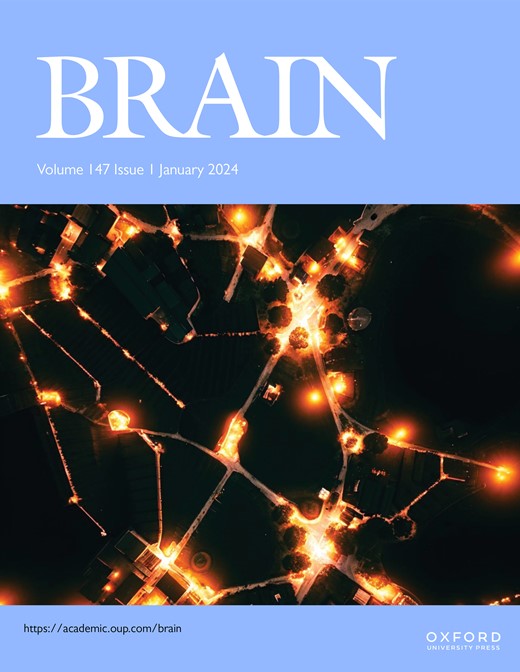Cholinergic basal forebrain degeneration in isolated REM sleep behaviour disorder
IF 10.6
1区 医学
Q1 CLINICAL NEUROLOGY
引用次数: 0
Abstract
Although growing evidence suggests that cholinergic basal forebrain degeneration is linked to cognitive impairment and axial motor symptoms in Lewy body disorders (LBDs), the cholinergic contribution to their prodromal phase remains largely unknown. Herein, we aimed to address three important yet unresolved questions focusing on prodromal LBDs: (1) to examine whether and where basal forebrain degeneration begins; (2) to determine how such alterations are related to other brain morphometric changes and monoaminergic deficits; and (3) to investigate the extent to which basal forebrain atrophy contributes to the clinical picture. We included 93 patients with polysomnography-confirmed isolated REM sleep behavior disorder (iRBD), 33 with de novo Parkinson’s disease (PD) with a premorbid history of RBD (dnPDRBD), and 36 healthy controls. Participants underwent baseline assessments including volumetric MRI, 18F-FP-CIT PET scan, the Movement Disorders Society-Unified Parkinson's Disease Rating Scale, and neuropsychological evaluations. Regional volumes of cholinergic nuclei 1, 2, and 3 (Ch1–3) and cholinergic nucleus 4 (Ch4) were extracted using probabilistic maps, and voxel-based and surface-based morphometric analyses were applied to identify basal forebrain atrophy-associated cortical and subcortical regions. Subgroups of patients with iRBD underwent repeated motor and cognitive assessments (38 and 34 patients for 2 and 4 years, respectively). Among the basal forebrain complex, Ch4 volumes, but not Ch1–3 volumes, were significantly reduced in patients with iRBD. This reduction positively correlated with limbic regions, including the amygdala and cingulate cortex, and, to a lesser extent, with the neocortical regions, particularly the frontal and temporal cortices. With respect to clinical symptoms, both Ch1–3 and Ch4 volume reductions were modestly associated with severe axial motor symptoms. Additionally, Ch1–3 volume reduction was associated with higher incidence of dementia and faster progression of memory impairment, whereas Ch4 volume reduction was associated with faster progression of limb bradykinesia. Using a multimodal imaging approach, we found that iRBD patients who later converted to PD showed predominant monoaminergic deficits but variable cholinergic involvement, and these patterns were similar to those observed in the dnPDRBD group. Conversely, iRBD patients who later converted to dementia with Lewy bodies showed predominant cholinergic deficits but variable monoaminergic involvement. This comprehensive analysis provides important implications for understanding how cholinergic basal forebrain degeneration is associated with brain morphometric changes, clinical outcomes, and monoaminergic degeneration during the prodromal phase of LBDs.孤立性快速眼动睡眠行为障碍的基底前脑胆碱能变性
尽管越来越多的证据表明,胆碱能性基底前脑变性与路易体疾病(lbd)的认知障碍和轴向运动症状有关,但胆碱能对其前驱期的贡献在很大程度上仍然未知。在此,我们的目的是解决三个重要的尚未解决的问题,集中在前驱lbd:(1)检查基底前脑变性是否和在哪里开始;(2)确定这些改变与其他脑形态变化和单胺能缺陷的关系;(3)探讨基底前脑萎缩对临床表现的影响程度。我们纳入了93例经多导睡眠图证实的孤立性快速眼动睡眠行为障碍(iRBD)患者,33例有RBD发病前病史的新生帕金森病(PD)患者(dnPDRBD)和36例健康对照。参与者接受了基线评估,包括体积MRI、18F-FP-CIT PET扫描、运动障碍学会统一帕金森病评定量表和神经心理学评估。使用概率图提取胆碱能核1、2和3 (Ch1-3)和胆碱能核4 (Ch4)的区域体积,并应用基于体素和基于表面的形态计量学分析来识别基底前脑萎缩相关的皮层和皮层下区域。iRBD患者亚组进行了重复的运动和认知评估(分别为38例和34例,为期2年和4年)。在基底前脑复合体中,iRBD患者的Ch4体积显著减少,但Ch1-3体积没有显著减少。这种减少与边缘区域呈正相关,包括杏仁核和扣带皮层,并且在较小程度上与新皮层区域呈正相关,特别是额叶和颞叶皮层。在临床症状方面,Ch1-3和Ch4体积减少与严重轴运动症状均有中度相关性。此外,Ch1-3体积减少与痴呆的高发病率和记忆障碍的更快进展有关,而Ch4体积减少与肢体运动迟缓的更快进展有关。使用多模态成像方法,我们发现iRBD患者后来转化为PD表现出主要的单胺能缺陷,但不同的胆碱能参与,这些模式与dnPDRBD组观察到的相似。相反,后来转化为路易体痴呆的iRBD患者表现出主要的胆碱能缺陷,但单胺能参与变化。这项综合分析为理解胆碱能基底前脑变性与lbd前驱期脑形态改变、临床结果和单胺能变性之间的关系提供了重要意义。
本文章由计算机程序翻译,如有差异,请以英文原文为准。
求助全文
约1分钟内获得全文
求助全文
来源期刊

Brain
医学-临床神经学
CiteScore
20.30
自引率
4.10%
发文量
458
审稿时长
3-6 weeks
期刊介绍:
Brain, a journal focused on clinical neurology and translational neuroscience, has been publishing landmark papers since 1878. The journal aims to expand its scope by including studies that shed light on disease mechanisms and conducting innovative clinical trials for brain disorders. With a wide range of topics covered, the Editorial Board represents the international readership and diverse coverage of the journal. Accepted articles are promptly posted online, typically within a few weeks of acceptance. As of 2022, Brain holds an impressive impact factor of 14.5, according to the Journal Citation Reports.
 求助内容:
求助内容: 应助结果提醒方式:
应助结果提醒方式:


